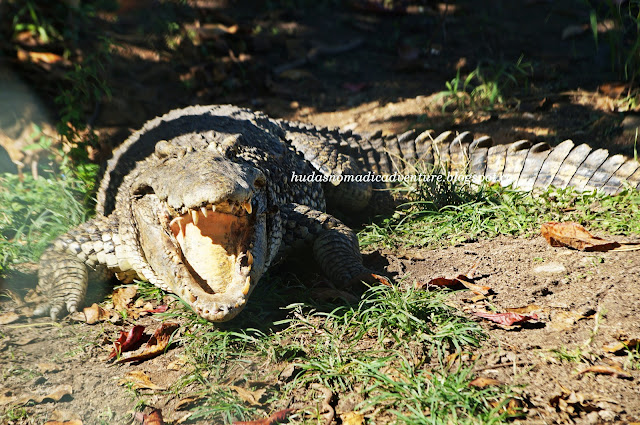For inquiring mind, Guamá is a municipality in the Santiago de Cuba Province of Cuba. It is located in the south-west of the province, and contains most of the Caribbean Sea coast west of Santiago de Cuba. After it was invaded by the Spanish empire, most of the Indian tribes (Ciboneys and
Taíno Arawaks) that inhabit the island were treated brutally by the Spaniard, where the slightest
infraction of Spanish rule, or refusal to accept Catholicism,
resulted in mass torture and executions. Tainos who never experienced any hard labor were forced to work in
gold mines or sugar cane plantations until they died of exhaustion.
They were initially replaced by Native American slaves from the
Southeast, but eventually, most slaves were either Africans or persons
of mixed African-Native American heritage.
holding baby crocodile, their skin is so amazingly soft.
Now this is one crocodile I will not be petting or getting near it.
When the Cuban revolution came to power in Cuba, it adopted Soviet practices of erasing ethnic identity. Castro and others wanted to minimize the racial stigmas and discrimination towards blacks and brown skinned Cubans that developed during the island’s three centuries of African slavery. Over the decades since then, however, the island’s leadership has finally realized that Cuba is not Russia. Cuba’s Native American heritage is very much a part of being “Cuban.” Since this realization, the government of Cuba has restored several Taino villages as a “living history” museums and tourist attractions. These projects include the above picture on the island of Guama It all represents a glimpse into the wiped out Indian tribes that inhabited the Island, including their way of life.
I think I interrupted a private moment here.
The whole Island is surrounded by beautiful wetland
more crocodiles, I'm a bit obsessed with them
Crocodile are deadly predators because they are silent observers and can actually run faster than most humans
You will find these crocodiles everywhere, albeit closely observed and locked away from people
As you may have noticed the shape of these statue' head, apparently the Indian tribes will bind the head of their infants to create the Alien-like shape. However, these tall statues are not an accurate depiction of how the Taino and Carib looked liked. Based on archeological findings, they were short and stocky people.
crocodile meat, I did not eat it, but did drink the Coconut juice
we took a boat ride across the Island, it was an amazing experience.
Aunt dome....fascinating in a creepy way
ps. the title of the post comes from Dakota Sioux proverb.





































3 comments:
OMG you are the new crododile hunter girl :D
That's an amazing shot !!! I love the other pictures and what is that cocoon kind of thing on your last pic?
xxx
lol, I don't about being a crocodile hunter, but thanks for your sweet comments. About the cocoon, its an ants dome, native to the Island.
What an awesome adventure.
Post a Comment